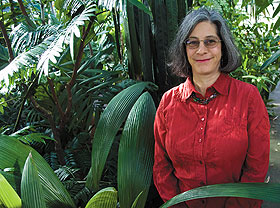  |
| HOME | THIS ISSUE | CALENDAR | GRANTS | BACK ISSUES | < BACK | NEXT > |
Biologist discusses new model for conservation of tropical forestsby Cindy Weiss - January 20, 2009
|
||||
| Since more than 90 percent of the world’s tropical forests are outside of reserves, parks, and protected areas, the survival of species of plants and animals that live in human-modified landscapes will require involving local communities in conservation strategies. That message comes from Robin Chazdon, professor of ecology and evolutionary biology in the College of Liberal Arts and Sciences, who gave an invited talk on the topic at a Smithsonian Institution symposium last week on “Prospects for Tropical Forest Biodiversity in a Human-Modified World.” Conservation strategies She calls for the development of biological corridors to connect remnants of old-growth forest to younger, secondary growth forests. The old-growth forests can act as “arks” to preserve species until the secondary growth forests are established as a new habitat. “If we can protect, expand, and enhance forest cover in these altered landscapes, the prognosis for conserving many forms of plant and animal life will improve in many regions,” she said. Chazdon has studied regrowth, or secondary growth tropical forests, since 1991, long before research on regrowth forests drew much interest. Her recent research, supported by the National Science Foundation, shows that seedlings and saplings of tree species from original growth tropical forests in Costa Rica have found a suitable habitat in regrowth areas. While other studies had shown that only 59 percent of the trees in the original forests were also found in regrowth areas, Chazdon and her collaborators took a broader look, including seedlings and saplings in the count as well as mature trees, and running statistical analyses to account for chance. She found that 90 percent of the original species were present in the secondary growth areas when the younger trees were counted too. That demonstrates that regrowth areas are important for recovering tree diversity, a finding that supports new conservation strategies such as building biological corridors and buffer zones surrounding existing reserves. The corridors would allow species threatened by the loss of old growth areas to move to regrowth areas to survive.
In many areas of Costa Rica, Chazdon has found, regrowth forests are regenerating in former cattle pastures that were abandoned after international demand for beef declined. The Smithsonian symposium was convened last week because satellite data and other research reveal that large tracts of previously logged or farmed areas are now regrowing. The symposium examined how and whether regrowth might mitigate the loss of biodiversity caused by massive deforestation and forest fragmentation over the past 50 years. Fostering biodiversity Shade-grown coffee, a traditional method of cultivating coffee beans, allows the forest canopy to remain intact, preserving habitat for threatened species, she notes. Cacao (the cocoa plant) will also grow in shade under the tropical forest canopy. In Brazil, where some areas “look like Iowa – not a tree in sight” due to the large-scale planting of soybeans and sugar cane, connecting forest fragments has enabled the highly endangered tamarin, a New World monkey, to increase its numbers to a point where the species is no longer endangered, she notes. That effort was led by a Brazilian businessman with a background in biology, who financed the project by selling carbon credits. While protected areas can be “arks” of preservation, local communities need to be involved, too, Chazdon maintains. Farmers and businesses can modify their practices so that both conservation goals and economic growth are served, she says. “It doesn’t have to be black and white,” she adds. “In many places, the gray areas are our best hope for retaining tropical biodiversity.” |
| ADVANCE HOME |

